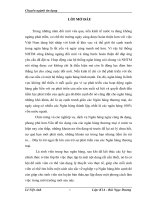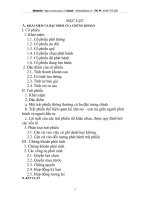Tìm Hiểu Về Sóng Elliot cơ bản
Bạn đang xem bản rút gọn của tài liệu. Xem và tải ngay bản đầy đủ của tài liệu tại đây (1.1 MB, 150 trang )
The Basics of the
Wave Principle
The e-learning Series for Traders
Presented by Wayne Gorman, Senior Tutorial Instructor
Elliott Wave International
P.O. Box 1618, Gainesville, GA 30503 USA
800-336-1618 or 770-536-0309
Fax 770-536-2514
www.elliottwave.com
© 2006 Elliott Wave International
The Basics of the Wave Principle
1.00
Introduction — Ralph Nelson Elliott’s Discovery
2.00
Motive Waves
3.00
Corrective Waves
4.00
Rules
5.00
Guidelines
6.00
Wave Personalities
7.00
Fibonacci Relationships
8.00
Summary
1.01
Financial Market Behavior Characteristics
Emotional (Unconscious)
Subjective
Impulsive
Ignorance and Uncertainty
Herding
Values Cannot Revert To Anything
1.02
The Wave Principle
Financial Markets are Patterned
1.03
Ralph Nelson Elliott
(1871 – 1948)
•
•
•
•
Crowd behavior trends and reverses in recognizable patterns,
that he called waves.
These structures link together to form larger versions of the
same patterns and how those, in turn, become the building
blocks for patterns of the next larger size and so on.
In 1938, he coined this phenomenon The Wave Principle.
Nature’s Law — The Secret of the Universe
1.04
1.05
1.06
1.07
1.08
1.09
A More Realistic Wave Depiction
1.10
1
2
4
5
3
6
1.11
5
6
7
1.12
The Wave Principle
Mankind’s progress (popularly measured by
stock market valuation) is not a straight line,
random or cyclical.
Growth and thereby social systems are moving in
a pattern consisting of five waves up and three
waves down.
This pattern reflects the alternation of growth and
non-growth or decline.
1.13
The Wave Principle
Predict Market Direction
Identify turning Points
Provide Guidance for Entering and Exiting Positions
1.14
2.00
MOTIVE WAVES
Key Characteristics
•
•
•
•
Five-wave structures, numbered 1-5
In the direction of the main trend of one larger degree
Wave 2 cannot retrace more than 100% of wave 1
Wave 3 can never be the shortest and is often the
longest
2.01
MOTIVE WAVES
Five-Wave Structures
•
Impulse
1. Extensions
2. Truncations
•
Diagonal Triangles
2.02
IMPULSE WAVES
Key Characteristics
•
•
•
Wave 4 never enters the price territory of wave 1.
Actionary waves 1, 3 and 5 are motive waves.
Wave 3 is always an impulse wave.
2.03
2.04
2.05
2.06
2.07
2.08
EXTENSIONS
Key Characteristics
•
•
•
•
Elongated impulse wave
Appears in either wave 1, 3 or 5
Often seen in wave 3 for the stock market
Often seen in wave 5 in commodities
2.09









